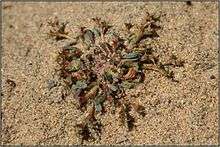Chorizanthe orcuttiana
Chorizanthe orcuttiana is a rare small annual plant in the buckwheat family, Polygonaceae. Its common name is San Diego spineflower, and it is endemic to San Diego County, California.
| Chorizanthe orcuttiana | |
|---|---|
 | |
| Scientific classification | |
| Kingdom: | Plantae |
| Clade: | Tracheophytes |
| Clade: | Angiosperms |
| Clade: | Eudicots |
| Order: | Caryophyllales |
| Family: | Polygonaceae |
| Genus: | Chorizanthe |
| Species: | C. orcuttiana |
| Binomial name | |
| Chorizanthe orcuttiana | |
The plant is diminutive, and a hand-lens is necessary for proper identification. The plant is very sensitive to temperature and precipitation, and under drought or hot conditions the seeds will not germinate or survive. The plant is visible anywhere from February through July during good rain year, but most years the plant is only visible from April to June. Each minute flower yields one seed.[1] This species is octoploid and probably arose through hybridization between other Chorizanthe, perhaps C. procumbens and C. polygonoides.[2]
The plant requires open habitat near the coast, such as sandstone bluffs and openings in maritime chaparral.[1] About 82% to 93% of San Diego County's maritime chaparral habitat has been destroyed for development and damaged by human activity such as recreation; there are just over 3000 acres remaining.[1] All the known occurrences are within five kilometers of the coastline.[1] It grows on soils of white sand which are neutral or somewhat acidic and low in organic material.[1][2] The substrates originate from iron-rich sandstone.
The plant was believed to be extinct until it was re-discovered on Point Loma.[1] Since its re-discovery, two additional populations were discovered on Naval Base Point Loma, and one small population is seen infrequently at Oak Crest Park in Encinitas, California.[1] Lately, this population has been made up of one single plant.[1] Most of its historic range has been developed, but due to its diminutive, infrequent nature, there is a significant chance that other undiscovered populations exist, possibly at Torrey Pines State Park, where it has been noted before.[1] The most recent estimate for a total remaining global population is between 470 and 3000 individuals.[1] It is a federally listed endangered species of the United States.
The worst threat to the species is the invasion of non-native plant species, such as ice plant (Carpobrotus edulis) and Natal grass (Melinis repens).[1] The plant is threatened by its limited number of populations and small population size, which increase the likelihood of extinction; the plant may be naturally rare, but its rarity is exacerbated by other conditions, such as fire suppression.[1]
References
- USFWS. Chorizanthe orcuttiana Five Year Review. December 2007.
- Reveal, J. L. Genus Chorizanthe. Taxonomic Treatment of Eriogonoideae (Polygonaceae).
